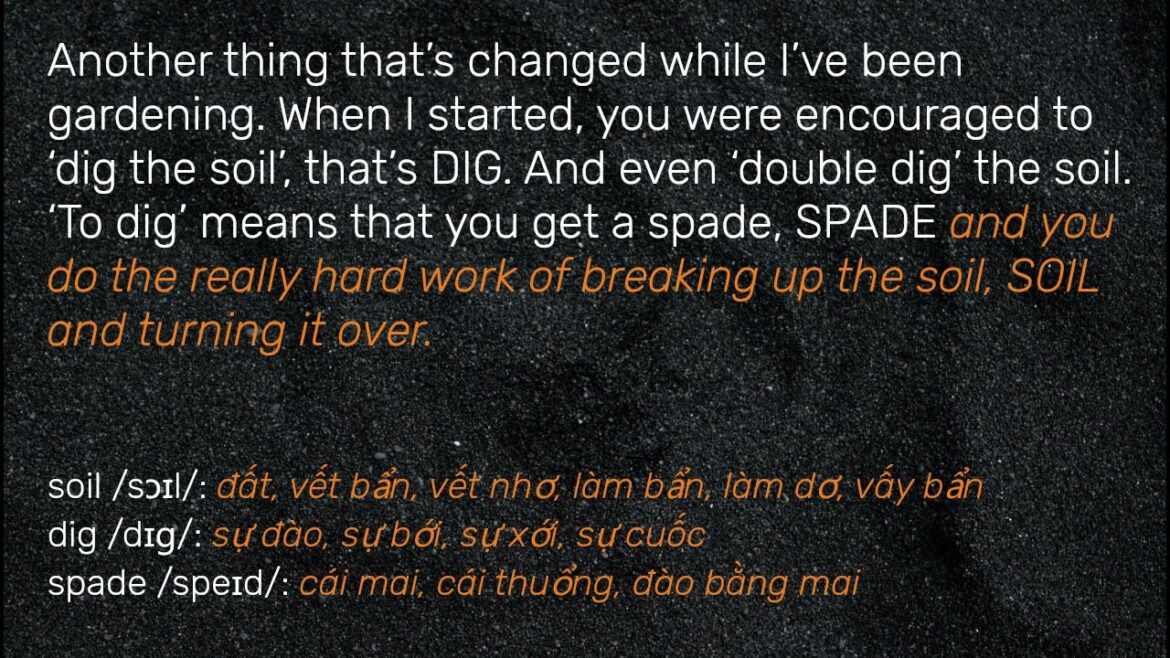56 English Listening Practice Stories – Speak English Naturally With UK Gardening Trends – Nói Tiếng Anh Tự Nhiên Với Xu Hướng Làm Vườn Ở Anh – part 3
Instead plants which don’t have an end date or perennial plants as we call them p e r n n i a l they’re much more popular perennial is an adjective and it can be used for plants but it can also be used for something which stays around forever gardeners by Design or by
Accident are f favoring a much less designed or contrived style if something’s contrived c o n t r i v e d it means a lot of thoughts gone into it a lot of planning instead gardeners are letting the plants grow more as they wish to letting the plants do their own thing
And Seed themselves as much as they wish if a plant sell seeds that’s s d it means it’s behaving in a natural way it drops its seeds and it makes more plants many of us are now light touch gardeners we just lend the garden a helping hand rather than trying to
Control everything in it are you also trying to use less water in your garden it’s good to collect as much as you can if you’ve the space in water butts that’s bu TT and it means a big container for holding water hundreds of liters perhaps I’ve got a system where if it
Rains on the roof of my house the water is collected in pipes and feeds into two big water butts sometimes there’s so little rain that they run out and I have to use yes the dreaded hose pipe but when there’s a rainstorm like there’s been the last couple of
Nights the water butts are all topped up again and they will water the pots in the garden for a couple more weeks another thing that’s changed while I’ve been gardening when I started you were encouraged to dig the soil that’s di G and even double dig the soil to dig
Means that you get a spade s p a d e and you do the really hard work of breaking up the soil s o i l and turning it over but it’s been recognized gradually that this breaking up of the soil is not a good thing it disturbs lots of
Microorganisms which benefit the soil and the garden and it destroys creatures little animals that you want in your garden like earthworms instead these days we focus on doing things like creating compost that’s c o m p o St T compost is really like new soil say you collect leaves and maybe your grass
Cuttings from your lawn and all that fruit and vegetable waste from your kitchen like apple cores and potato peelings pile it together in a compost heap that’s h e a p and if you leave it long enough the worms earthworms w r Ms they make it into new
Soil rather than double digging it’s much better to put compost on the surface of your garden that’s what’s called top dressing so our Gardens in the UK are becoming more sustainable more organic gone for most people are artificial chemicals like pesticides and fertilizers and our Gardens are also much more friendly to
Wildlife I’m not quite yet at the point where I encourage butterflies I don’t want caterpillars eating my leaves I’ve got enough slugs and snails to do that a snail s n a i l they have a shell and if you visit France as I do sometimes you eat them with garlic
Butter that’s a snail but more often I meet them in my garden when they’re eating things I don’t want them to eat we do encourage Birds into our garden though and there’s always food for them and we see quite a lot of different types and we also have drinking bows for
Hedgehogs that’s h e d g e h o gs and Badgers and foxes are well welcome too as long as they don’t fight with our cats and by the way our cats don’t often catch animals or Birds they do a lot of looking but they’re rarely successful which is a good
Thing so there’s a run through of my thoughts on gardening in the UK and the gradual changes that I’m making and many other people are making too also a bit on the value of gardens I hope this is nice relaxed summer listening for you and if you want
To tell us about your garden or your balcony gardening then please get in touch enough for now have a lovely day speak to you again soon goodbye


1 Comment
56 English Listening Practice Stories – Speak English Naturally With UK Gardening Trends – part 3